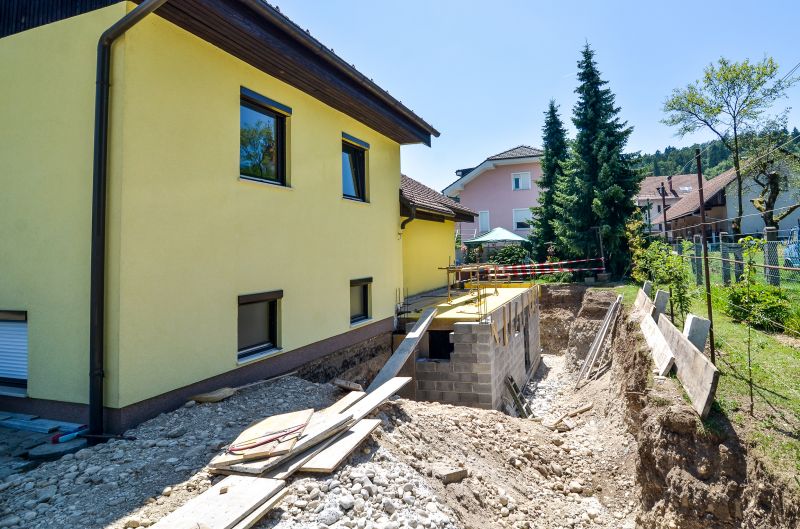Essential Foundation Repair Products For Structural Integrity
Choose from trusted materials and tools that ensure your foundation remains solid and secure over time.
 Foundation issues can pose significant challenges for homeowners, especially in regions like Mound, MN, where shifting soil and moisture fluctuations are common. Addressing these concerns often involves selecting appropriate repair products that can stabilize and reinforce the foundation structure. From underpinning systems to epoxy injections, there is a variety of solutions designed to suit different types of foundation problems. Understanding the purpose and application of each product type can help homeowners make informed decisions tailored to their specific needs.
Foundation issues can pose significant challenges for homeowners, especially in regions like Mound, MN, where shifting soil and moisture fluctuations are common. Addressing these concerns often involves selecting appropriate repair products that can stabilize and reinforce the foundation structure. From underpinning systems to epoxy injections, there is a variety of solutions designed to suit different types of foundation problems. Understanding the purpose and application of each product type can help homeowners make informed decisions tailored to their specific needs.
Top Overall Option
Polyurethane Foam Injection System
Polyurethane foam injection systems are versatile and effective for addressing minor to moderate foundation settling and cracking. They work by expanding beneath the foundation to lift and stabilize affected areas, filling voids and cracks with a durable, expanding foam. This method is minimally invasive and can be applied relatively quickly, making it a popular choice for homeowners seeking a non-disruptive repair solution. Proper application by trained professionals can enhance the stability of the foundation and help prevent further movement or damage.
Types of Products For Foundation Repairs
Carbon Fiber Reinforcement Strips
Used to reinforce and stabilize cracked walls and slabs, these strips are applied with adhesive to provide additional tensile strength.
Helical Piles
Deep foundation supports that are screwed into the ground to provide extra stability for settling or shifting structures.
Mudjacking and Slab Jacking Materials
Materials like grout or foam used to lift and level sunken concrete slabs and driveways.
Epoxy Injection Kits
Designed to seal and bond cracks in concrete, restoring structural integrity and preventing water intrusion.
Steel Push Piers
Support systems driven into bedrock or stable soil to lift and stabilize sagging foundations.
Soil Stabilization Chemicals
Injectable solutions that improve soil compaction and reduce shifting beneath the foundation.
Waterproofing Membranes
Protective barriers applied to foundation walls to prevent water penetration and moisture-related issues.
Drainage Systems
French drains and sump pumps that help divert water away from the foundation, reducing hydrostatic pressure.
Underpinning Piers
Support structures placed beneath the foundation to extend its load-bearing capacity.
Polyurethane Foam Injection Systems
Expandable foam used to fill voids and lift settled slabs or sections of the foundation.
Grout and Sealants
Materials used to seal cracks and prevent water infiltration in foundation walls.
Foundation Braces and Supports
Structural supports installed to reinforce walls and prevent further movement.
Vapor Barriers
Sheets of plastic or other materials installed to control moisture vapor beneath slabs.
Anchoring Systems
Devices that secure loose or bowing walls to prevent collapse or further damage.
Soil Replacement Materials
High-quality fill soils used during underpinning or stabilization projects.
Concrete Patch and Repair Mixes
Specialized mixes for patching cracks and surface damage in concrete foundations.
Drainage Pipes and Outlets
Components designed to facilitate proper water flow away from the foundation.
Popular Choices
Widely used for minor lifting and stabilization, these systems are favored for their quick application and minimal disruption.
Commonly selected for crack stabilization, these strips offer a non-invasive way to strengthen walls.
Popular for underpinning, especially in cases with significant settling or poor soil conditions.
A preferred solution for leveling sunken concrete slabs quickly and efficiently.
Frequently chosen to seal cracks and prevent water intrusion, preserving the integrity of the foundation.
Often used for lifting and supporting sagging sections of the foundation.
Commonly installed to prevent water seepage and moisture buildup in basement walls.
Effective for redirecting water away from foundations, reducing hydrostatic pressure.
Popular in crawl spaces and under slabs to control moisture vapor.
Used to stabilize bowing or leaning walls to prevent further movement.
Installed to reinforce walls and prevent collapse or further cracking.
Help manage water flow and reduce pooling around the foundation.
Used for bridging weak spots and providing additional support to compromised areas.
Applied for surface repairs and crack filling on concrete surfaces.
Injected to improve soil consistency beneath the foundation, reducing shifting.
Commonly used for deep foundation support in problematic soil conditions.
Popular for filling voids and stabilizing foundation walls.
Foundation repair products are generally designed to either lift, stabilize, or seal cracks and gaps. Some products are intended for preventative maintenance, while others are used for active repairs. The effectiveness of these solutions depends on proper assessment and installation, which is why consulting with a foundation specialist is often recommended. Regardless of the chosen method, safety and durability should be primary considerations when selecting repair materials.
In addition to structural reinforcements, there are products aimed at waterproofing and moisture management, which can help prevent future issues related to water intrusion. Proper drainage systems and vapor barriers are vital components in maintaining a stable foundation environment. Selecting high-quality, appropriate products can contribute to the longevity of the repair and reduce the likelihood of recurring problems.
Overall, the market offers a broad range of foundation repair products suited for various scenarios and budgets. Homeowners in Mound, MN, should consider their specific foundation condition, the extent of damage, and expert recommendations when choosing products. Investing in the right solutions can help ensure the stability and safety of a home over the long term.
